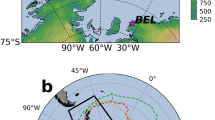Abstract
The linkage between changes in air mass distribution and temperature trends from 1971 to 2010 is explored in the Hudson Bay/Foxe Basin region. Statistically significant temperature increases were found of varying spatial and temporal magnitude. Concurrent statistically significant changes in air mass frequency at the same locations were also detected, particularly in the declining frequency of dry polar (DP) air. These two sets of changes were found to be linked, and we thus conclude that the heterogeneity of the climatic warming signal in the region is at least partially the result of a fundamental shift in the concurrent air mass frequency in addition to global and regional changes in radiative forcing due to increases in long-lived greenhouse gases.




Similar content being viewed by others
References
Alexander MA, Bhatt US, Walsh JE, Timlin MS, Miller JS, Scott JD (2004) The atmospheric response to realistic Arctic sea ice anomalies in an AGCM during winter. J Clim 17(5):890–905
Ford J, Gough WA, Laidler GJ, Macdonald J, Irngaut C, Qrunnut K (2009) Sea ice, climate change, and community vulnerability in northern Foxe Basin. Canada Clim Res 38:137–154
Francis JA, Vavrus SJ (2012) Evidence linking Arctic amplification to extreme weather in mid-latitudes. Geophys Res Lett 39(6):L06801
Francis JA, Vavrus SJ (2015) Evidence for a wavier jet stream in response to rapid Arctic warming. Environ Res Lett 10(1):014005
Gagnon AS, Gough WA (2002) Hydro-climatic trends in the Hudson Bay region, Canada. Can J Water Res 27:245–262
Gagnon AS, Gough WA (2005a) Climate change scenarios for the Hudson Bay region: an intermodel comparison. Clim Chang 69:269–297
Gagnon AS, Gough WA (2005b) Trends in the dates of ice freeze-up and breakup over Hudson Bay, Canada. Arctic 58(4):370–382
Gagnon AS, Gough WA (2006) East/west asymmetry in ice thickness trends over Hudson Bay. Canada Clim Res 32:177–186
Gough WA (2008) Theoretical considerations of day-to-day temperature variability applied to Toronto and Calgary, Canada data. Theor Appl Climatol 94:97–105
Gough WA, Wolfe E (2001) Climate warming scenarios for Hudson Bay, Canada from a general circulation model. Arctic 54:142–148
Gough WA, Cornwell AR, Tsuji LJS (2004a) Trends in seasonal sea ice duration in southwestern Hudson Bay. Arctic 57:299–305
Gough WA, Gagnon AS, Lau HP (2004b) Interannual variability of Hudson Bay ice thickness. Polar Geog 28(3):222–238
Hochheim KP, Barber DG (2010) Atmospheric forcing of sea ice in Hudson Bay during the fall period, 1980–2005. J Geophys Res 115(C05009)
Hochheim KP, Barber DG (2014) An update on the ice climatology of the Hudson Bay system. Arct Antarct Alp Res 46(1):66–83
Hochheim KP, Lukovich JV, Barber DG (2011) Atmospheric forcing of sea ice in Hudson Bay during the spring period, 1980–2005. J Mar Syst 88:476–487
Hondula DM, Davis RE (2011) Climatology of winter transition days for the contiguous USA, 1951–2007. Theor Appl Climatol 103(1):27–37
Kalkstein LS, Nichols MC, Barthel CD, Greene JS (1996) A new spatial synoptic classification: application to air-mass analysis. Inter J Clim 16(9):983–1004
Kowal S, Gough WA, Butler K (2015) Temporal evolution of Hudson Bay sea ice (1971–2011). Theor Appl Climatol (submitted)
Laidler GJ, Ford J, Gough WA, Ikummaq T, Gagnon AS, Kowal S (2009) Travelling and hunting in a changing Arctic: assessing Inuit vulnerability to sea ice change in Igloolik, Nunavut. ClimChang 94:363–397
Peings Y, Magnusdottir G (2014) Response of the wintertime northern hemisphere atmospheric circulation to current and projected sea ice decline. A numerical study with CAM5. J Clim 27(1):244–264
Rouse WR (1991) Impacts of Hudson Bay on the terrestrial climate of the Hudson Bay lowlands. Arct Alp Res 23(1):24–30
Screen JA (2013) Influence of Arctic sea ice on European summer precipitation. Environ Res Lett 8(4):044015
Screen JA, Simmonds I (2010) The central role of diminishing sea ice in recent Arctic temperature amplification. Nature 464:1334–1337
Sheridan S (2002) The redevelopment of a weather-type classification scheme for North America. Int J Climatol 22(1):51–68. doi:10.1002/joc.709
Stroeve JC, Markus T, Boisvert L, Miller J, Barnett A (2014) Changes in Arctic melt season and implications for sea ice loss. Geophys Res Lett 41(4):1216–1225
Tan J, Kalkstein LS, Huang J, Lin S, Yin H, Shao D (2004) An operational heat/health warning system in Shanghai. Int J Biometeorol 48(3):157–162
Tang Q, Zhang X, Yang X, Francis JA (2013) Cold winter extremes in northern continents linked to Arctic sea ice loss. Environ Res Lett 8(1):014036
Tang Q, Zhang X, Francis JA (2014) Extreme summer weather in northern mid-latitudes linked to a vanishing cryosphere. Nat Clim Chang 4(1):45–50
Vincent LA, Wang XL, Milewska EJ, Wan H, Yang F, Swail V (2012). A second generation of homogenized Canadian monthly surface air temperature for climate trend analysis. J Geophys Res Atmos 117(D18110). doi:10.1029/2012JD017859
Zhang K, Rood RB, Michailidis G, Oswald EM, Schwartz JD, Zanobetti A, Ebi KL, O’Neill MS (2012) Comparing exposure metrics for classifying dangerous heat in heat wave and health warning systems. Environ Int 46:23–29
Author information
Authors and Affiliations
Corresponding author
Rights and permissions
About this article
Cite this article
Leung, A., Gough, W. Air mass distribution and the heterogeneity of the climate change signal in the Hudson Bay/Foxe Basin region, Canada. Theor Appl Climatol 125, 583–592 (2016). https://doi.org/10.1007/s00704-015-1523-x
Received:
Accepted:
Published:
Issue Date:
DOI: https://doi.org/10.1007/s00704-015-1523-x




